Islington Farmers Market with food writer Shu Han Lee
Trusting one's senses and instincts. reflecting on a personal cooking journey and experiences in Singapore. A runaway crab, and two seasonal recipes from Shu's book Agak Agak
Good morning from Queen of Markets. Thank you for being here. I’d love to hear from you in comments or by email; please do let me know what you’d like me to write about. More markets? More seasonal food or producer stories? I have plenty of ideas in the planning stage.
At the moment all of my pieces are free to read; sooner or later my first paywall piece will arrive. Do consider supporting my newsletter and upgrading to paid. It enables me to do more as a writer; deep dives into markets, food stories, farmers and producers. Some posts will always be free and others below the paywall.
Thank you for your kind comments; being told that mine is the first newsletter you turn to is wonderful, and thank you to
for recently recommending me. If you like my writing and you’re on Substack yourself, please recommend Queen of Markets. If you’re not; can you share a post you like with a friend and click on the heart to like a post? It helps other people find my work.Shu Han Lee is a cookery author and the founder behind indie sauce brand Rempapa Spice Co. I first met Shu when she was managing Pimlico farmers market for London Farmers Markets.
She grew up in Singapore and moved to London in 2009. Missing the flavours of home, she started cooking and hosting Singaporean supper clubs from her home and pop-up events all over the UK. In 2018, Shu started selling her small-batch spice pastes and sambal from a farmer's market stall and it has since grown to be found on the shelves of Selfridges, Whole Foods, Ocado and independent delis across the UK. Shu also works as a freelance recipe developer for brands such as Wagamama, Tilda, Kikkoman and Jamie Oliver.
Her first book Chicken & Rice, Fresh & Easy Southeast Asian Recipes was published in 2016. Her latest is Agak Agak, Everyday Recipes from Singapore (2024, Hardie Grant/ Quadrille, Penguin Random House)
Recently Felicity Cloake included Shu in her Guardian Newspapers Feast roundup of classic cookbook reissues; Shu Han-Lee’s love letter to the flavours of her native Singapore, Chicken and Rice featured amongst greats she’d love to see given a second moment in the spotlight.
Nigella Lawson has highlighted Agak Agak on her website too.
We’re meeting at Islington Farmers Market on Chapel Market in North London, Shu’s choice. The Farmers Market takes place every Sunday on Chapel Market in Islington. It celebrated its 25th anniversary this year and was the first farmers market to open in London.
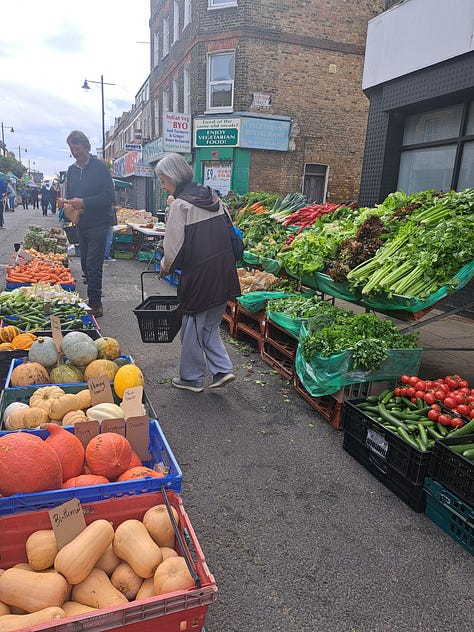
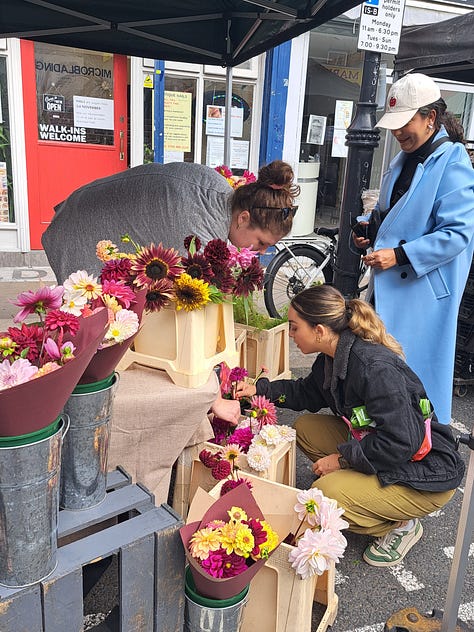
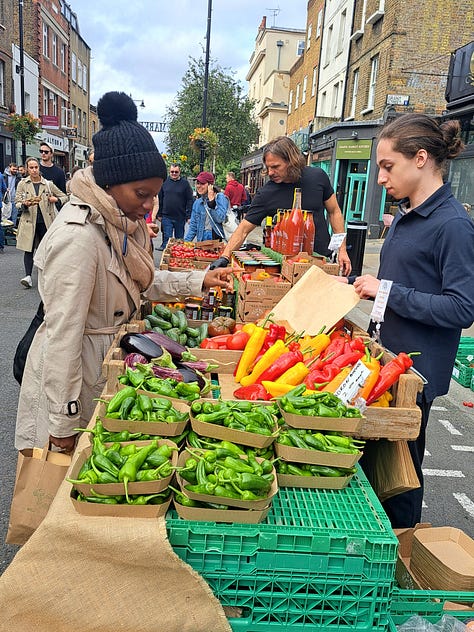
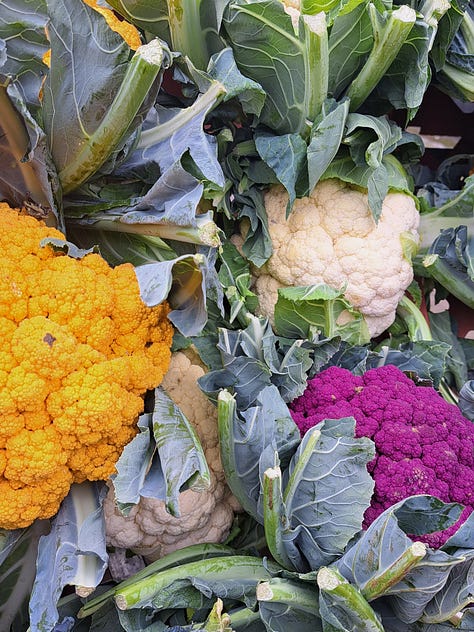


I’m not ashamed to be borrowing a great question from the pages of
What is it about farmers markets that you love?
I love that you get produce that's as fresh as possible and I think a lot about cooking is actually using good produce and then you don't have to do too much to it.
I grew up in Singapore where there is not a lot of farming culture so it was a huge eye -opener when I came here and I tasted my first tomato just raw because you would never use it raw in Singapore you use it cooked to take out all the mealiness and the thick skin and it just surprised me how amazing it could taste on its own.
It inspires myself as a cook quite a lot; I love coming to farmers markets to check out what's the latest, what's the freshest in season but also you get to meet a lot of the farmers and makers themselves which I think is something you just don't get anymore especially when you shop in supermarkets.
Are there any particular ingredients that really inspire you to cook?
I know most chefs, especially male restaurant chefs, love using meat and it's a key part of a dish or a meal when they think about new menus, but for me it's vegetables because it really varies through the seasons. I get excited by all the colours and the changes that you get in vegetables through the seasons.
Now, for instance. I love autumn because I love squash, all squashes, the various colours and textures. You would think Singapore being a tropical place has lots more salad-y type ingredients, but actually a lot of the dishes I grew up with make use of vegetables like cauliflower, tomatoes, squashes and pumpkins so this is the time of the year where I get really excited.
Who is the biggest food influence in your life?
It's probably my mom. She's such an amazing cook. So we always grew up with good food but she wasn't very good at teaching us how to cook.
Like most Asian moms, she wanted us away from the kitchen and either practicing our piano, which never panned out, or our homework. So we spent very little time in the kitchen growing up, but I always remembered having good food, smelling good food once I came home from school.
One of the things I wrote about in the book as well is that while we weren't allowed to cook, we were allowed to watch. And I think we were allowed to taste when we spent time with her in the kitchen.
It helped me understand the senses when you cook. I saw her put in the harder stalks first and the softer leaves later. I watched her stir in mysterious sauces from jars!
I think that's always given me a love for the drama, the theatre of cooking, and obviously you get the delicious meal at the end. So while we never really cooked, I think food was a big part of our culture and of my family.
She really instilled that in us from a very young age. And she was also very, very anti junk food. So we grew up with nice cooked meals which inspired me when I moved here, to not resort to what every other student was probably doing back then, which was going out for McDonald's.
When I was hungry, the first instinct that came to my head was how do I make a meal for myself, even though I didn't know how at all.
When we first met, you were managing Pimlico farmers market. Did you tend to overbuy because you're surrounded by so much amazing food, or were you able to buy just what you needed?
I think my first few weeks I definitely overbought. I was by myself, the food couldn't be used up as quickly, and so you quickly learn your lesson. And also, because I was there every weekend, I learned. There were a few favorites I would always get. Always tomatoes from The Tomato Stall, especially in summer, and then always a new vegetable that I've never encountered. I think that was part of my food or veg education here in the UK, so it was quite a fun learning experience at the markets.
Managing a Farmers Market was what really opened my eyes up to the world of great produce. And great farmers and makers as well, who really care about the food they grow, because I spent three four hours with them, so you get to really know some of them. I went to visit Chegworth Valley once with Linda (Co-owner and stall holder), because she always said, come over. And it was really nice seeing people who really care about apples and all the various types and varieties. Being on the farm you really see how important it is to be connected to the food and the people who grow it.
First thing that comes to mind, what was your favourite thing to eat as a child?
Tau Yew Bak; braised pork belly, usually with tofu or eggs or shiitake mushrooms added to it. And it's one of those dishes that just get better as time goes on. She will make a huge pot of it, and have it through the week. And I think that's probably a very unusual dish for a child here, for sure.
It really surprised me when I see friends here giving their kids something like turkey dinosaurs. I never really got it because we just ate what our parents ate.
I think we can give children a little bit more freedom to try foods as they grow up.
Tell me the name of your new book and what it means.
Listen to Shu pronouncing the name of her book…
The new cookbook is called Agak Agak. It comes from the Malay colloquial term for ‘somewhat’. or ‘more or less’, and you use it in different contexts, but I think it's really in the kitchen where it really comes to life, and I think this is not just a Singaporean way of cooking. This is something you find in all good home cooks, where you learn to rely less on measurements, tools, and to trust your senses, your instincts, to also be able to adapt to ingredients to preferences, as well.
So in my mind, that’s a very Singaporean way of cooking. But like I said, it can be more than that. I think Italians have this feature in their way of cooking as well. And I just wanted to bring that out in the book, because it's very Singapore, but because it's also the way I learned to cook here in the UK. I learned to cook a bit later, and I'm dealing with different ingredients here. And 15 years ago, there was a lack of availability of certain sauces, spices, for instance, that I might be used to. So you really had to adapt and make do.
That sort of adaptability, trusting your senses a bit, making do, is such a big part of me as a cook now, and you'll find that in the recipes. They are authentically Singaporean in spirit. There are a lot of classic dishes that you'll recognize, but I've made a lot simpler. Many of them I’ve given substitutes if you can't find the same herbs, for instance. And I also know not many people like the same spice level, for instance that I do, and I always tell people to keep tasting and then add more salt or sugar or maybe tone down the chili if you want. That kind of spirit of cooking, not just the recipes that I wanted to bring across in the book.
Singapore is such a mix; we are Chinese, Malay, Indian, and we had our colonial history as a British colony.
What do you hope readers will feel when they're in the pages of your new book?
I really hope they feel like they can cook the recipes in there. One of my pet peeves with cookbooks is when it feels intimidating or the ingredients list looks way too difficult to get hold of, often times we don't even cook from it.
That's not what I want as a food writer. I think the whole point is that people can try these recipes, and so that's number one, but I also hope they get the kind of colour and texture and exciting cultures of Singapore from the pages of the book.
When we were working on the book, right at the start we had a meeting with the design team, and I put together a mood board, and it was the most colourful, crazy mood board.
And I said, don't worry about clashing textures or fonts or colours, because that's all very Singaporean. Singapore is such a mix; we are a mix of Chinese, Malay, Indian, and then we had our colonial history as a British colony.
So the food represents that, we haven’t all kept to ‘our’ food. There's a lot of intermingling, and I think what makes Singaporean chefs so exciting is they have never been precious about mixing cultures and flavours.
Shu on the story of Singapore chili crab and bringing out the experimental nature of Singaporean cooking:-
She says in Agak Agak; young Singaporean chefs have turned this explosive dish into a pasta sauce, and you’ll find chilli crab spaghetti served in many modern bistros.
I love the chili crab spaghetti recipe for giving readers an inning. It’s comfortable, slightly different. Shu is enthusiastic about not having to deal with a whole crab.
Just no crab shell, no live crabs to deal with. I still have memories of my mom chasing after a crab, one escaping from the bucket into the garden, so I just watched my mom running after the crab with a knife.
Did she catch it?
No, I don't think so, actually. We lost the crab. I don't know what happened. It probably got eaten by a bird.
If you could cook for anyone, who would you choose to have at your table?
I struggle with this question. There are a lot of food writers that I really admire, and it would be so amazing to have them all together at the table, all writing about foods from different cultures as well. So I'd really love to have Fuchsia Dunlop because of all her insight into Chinese cooking. Singapore's got lots of Chinese dishes as well, Chinese immigrant dishes, from the southern part of China. So I just wonder what she would think about it. I would love to have Asma Khan, one of my favorite kind of chefs in London, and also pioneering the way for a lot of female chefs. Indian food is a huge part of our culture. And I want to know her view on the kind of Indian food we have in Singapore. And then finally, a really good friend, Uyen Luu writes about Vietnamese food, and that's a weird one, where it's very close to Singapore, and the flavors are familiar, but they use a lot more fresh herbs and salads. And I would love to see how, with every one of us coming to the table, what sort of thoughts and ideas we might have about Singaporean food, and they are all female chefs and food writers who have done brilliant work for their cultures and for the food scene, cookbooks in the UK and beyond.
That'd be amazing, if you all cook together. I'd come to that.
Really, it should be a potluck.
I love your phrase in the book, ‘I encourage you to keep trying, testing and tasting.’ Do you think we're not intuitive enough when we cook?
I do think certain food cultures have a bit more playfulness with their food.
I think the Italians do it well. I only learned about this this year, actually, that they have this thing called quanto basta which means as much as needed, which is amazing.
That's very much like an agak agak type of approach, through recipes and cooking. I think with British cooking, a lot of people don't cook from a young age. So when they do learn, they tend to be quite heavily reliant on recipes.
To be fair, I didn't really cook from a young age. But we've always been encouraged, even when we're young and not fully in the kitchen, to always taste and test.
Pick one recipe for readers to cook, what would it be?
The chilli crab spaghetti for sure and now, because it's autumn, try the roast pumpkin masa lemak. Masa lemak just means cooking in coconut milk with lemongrass and spices. So it’s very versatile through the seasons, you just change it with whatever vegetables in the season. But right now it's really really good with crown prince squash for instance.
The book reads like a love letter to the food you grew up with. What did your family think of it?
I was back in Singapore in July because I wanted to properly give them the book.
It's very personal because I also took lots of photos with a little film camera last time I was there and some of them made it into the book. So actually a lot of my family members are dotted throughout the book.
I really wanted to see the reaction. My dad's reaction; he flipped straight past all the recipes and looked for his photo . So that was my dad.
But I could tell he's proud. He would never really voice it in words. My mom's the same. She actually didn't say much. She just had a silent little nod of approval.
I had a couple of book events in Singapore and she didn't come. But then she sent my brother to buy eight copies. This is the most Asian mom way of saying she is proud of me. And I guess that she is supportive. Never, never directly.
Stalls we visited
The Godalming Flower Company
Two delicious recipes
Extracted from Agak Agak, by Shu Han Lee (Hardie Grant Books £26). Photography by Ola O. Smit.
Roast Pumpkin Masak Lemak
‘Masak lemak’ simply means ‘to cook in coconut milk’. This is a recipe that can work with all sorts of ingredients. Its versatility means I often serve a variation of this when I have non-meat-eating guests over – fresh greens in spring, aubergines (eggplants) in summer, squash in autumn and cavolo nero in winter
Ingredients
1 kg (2 lb 4 oz) sweet winter squash (I used red kuri but any will do)
2–3 tbsp vegetable oil
¾ tsp and a pinch of sea salt
200 ml (7 fl oz/generous ¾ cup) coconut milk
200 ml (7 fl oz/generous ¾ cup) water
FOR THE REMPAH (SPICE PASTE) CURRIES
100 g (3½ oz) shallots, roughly chopped
4 garlic cloves thumb-sized piece
(15 g/½ oz) fresh ginger, peeled and roughly chopped
3 large red chillies, roughly chopped
½ tsp ground turmeric
¼ tsp ground coriander
TO FINISH
juice of ½ lime
handful of fresh coriander (cilantro), roughly chopped
1 red chilli, thinly sliced (optional)
Preheat the oven to 210°C/190°C fan/410°F/gas mark 3.
Cut the squash into 2–3 cm (¾–1¼ in) wedges, removing any seeds and fibrous bits and leaving the skin on. Toss with the oil and a big pinch of sea salt and spread out on a large, deep roasting tray. Roast for 20 minutes. In the meantime, pound all the spice paste ingredients using a pestle and mortar or whizz in a small blender until you get a fine paste. Fry the paste in a saucepan over medium heat until very fragrant, about 10 minutes. Stir in the coconut milk and water and bring to a simmer. Season with ¾ teaspoon of salt, or to taste. Pour the sauce over the squash in the roasting tray, cover with foil, and continue to roast in the oven for another 20–25 minutes or until tender. To serve, finish with a squeeze of lime, the chopped coriander and some chopped chilli, if you like.
Second Auntie’s Achar
All my Aunties have a signature dish that they bring to big family reunions. My Second Auntie is known as the achar maker of the family. This Peranakan pickle of vegetables, pineapple and roasted peanuts is an explosion of colour, taste and texture. Every bite gives you a different crunch and a different hit of sweet, sour or spicy. It’s the perfect thing to go alongside coconut rice, rich meats and all sorts of Nonya braises and curries. I also often eat it straight from the jar. Below is an adaptation of her original recipe.
Ingredients
MAKES TWO 1-LITRE (34 FL OZ/41/4 CUPS) KILNER JARS
500 g (1 lb 2 oz) cucumber, seeds removed, cut into finger-length batons
200 g (7 oz) carrots, cut into finger-length batons
200 g (7 oz) cauliflower, broken into small florets
2 tbsp coarse sea salt
300 g (101/2 oz) pineapple, peeled and cut into small pieces
100 g (3½ oz) white sesame seeds
200 g (7 oz) roasted peanuts
FOR THE PICKLING MARINADE
100 g (3½ oz) shallots
6 large (150 g/51/2 oz) fresh red chillies, deseeded
1 tsp ground turmeric
100 ml (3½ fl oz/scant ½ cup) vegetable oil, for frying
125 ml (4 fl oz/½ cup) white rice vinegar, or white wine vinegar
150 g (51/2 oz/2/3 cup) caster (superfine) sugar
Prepare the cucumber, carrots and cauliflower, toss with salt and set aside to sweat for 30 minutes. Meanwhile, for the pickling marinade, pound the shallots, chilli and turmeric using a pestle and mortar or whizz in a small blender until you get a fine paste. Fry the spice paste in a pan over medium heat until aromatic, about 15 minutes. Have a taste – it shouldn’t have any of that raw taste of shallots. Add the vinegar and sugar and bring to a simmer, then turn the heat off and let cool.
In a separate dry frying pan, toast the sesame seeds until golden, watching carefully to make sure they don’t burn, and set aside to cool. Crush the roasted peanuts and combine with the sesame seeds. Back to the vegetables. Drain any juices from the vegetables – the cucumbers especially will release quite a bit of moisture, so squeeze them as dry as you can. Combine with the pineapple pieces, sesame seeds and peanuts. Pour the pickling marinade over and mix well. Transfer into glass jars, then seal and store in the fridge. It’s ok if it looks like the vegetables aren’t quite fully submerged in the pickling liquid, as they will continue to release their own juices as they pickle. The pickle is ready the next day and will last for 2 weeks in the fridge (if you can resist)









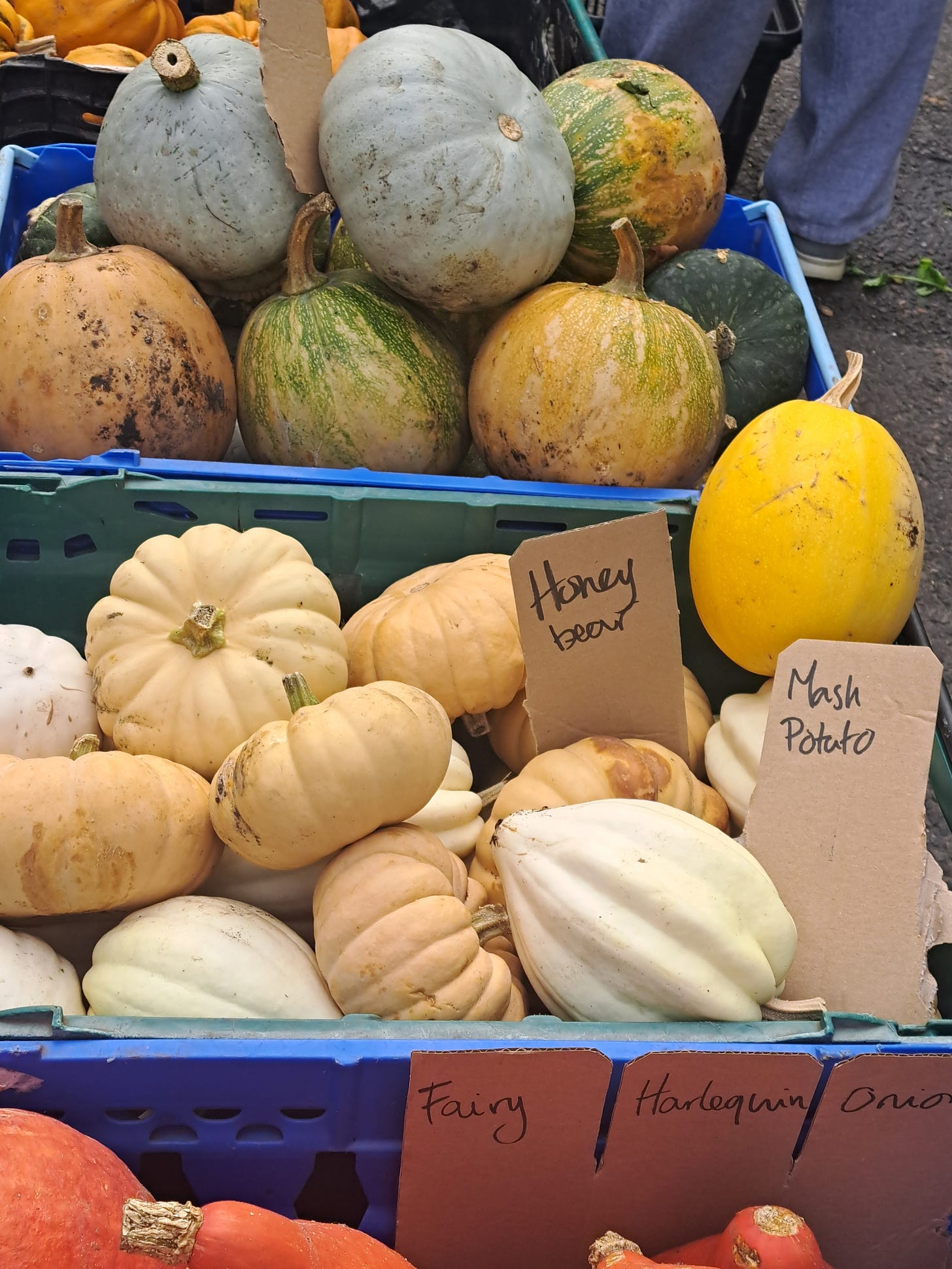

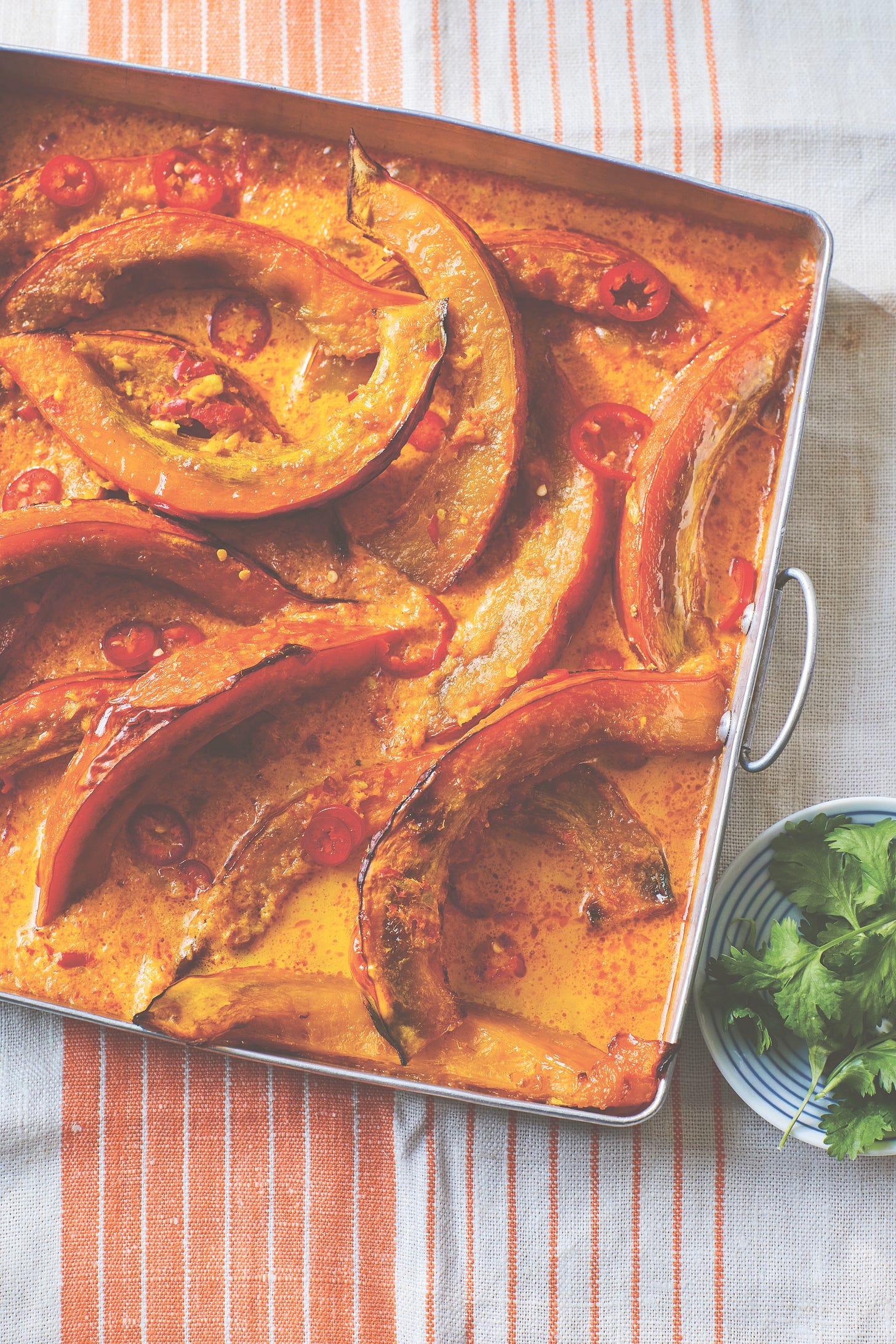

I love this post! I’m inspired to visit all of these markets to buy beautiful, organic fruit and vegetables. I have a pumpkin in my kitchen with this recipe’s name on it!
My parents were both in the RAF and stationed in Singapore in the late 60’s where my older sister was born. I’m very interested in reading about Singaporean food culture.
Love the look of both of these recipes - yum!